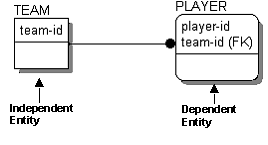
As you develop your data model, you may discover certain entities that depend upon the value of the foreign key attribute for uniqueness. For these entities, the foreign key must be a part of the primary key of the child entity (above the line) in order to uniquely define each entity.
In relational terms, a child entity that depends on the foreign key attribute for uniqueness is called a dependent entity. In IDEF1X notation, dependent entities are represented as round-cornered boxes.
Entities that do not depend on any other entity in the model for identification are called independent entities. In IE and IDEF1X, independent entities are represented as square-cornered boxes.

Dependent entities are further classified as existence dependent, which means the dependent entity cannot exist unless its parent does, and identification dependent, which means that the dependent entity cannot be identified without using the key of the parent. The PLAYER entity is identification dependent but not existence dependent, since PLAYERs can exist if they are not on a TEAM.
In contrast, there are situations where an entity is existence dependent on another entity. Consider two entities: ORDER, which a business uses to track customer orders, and LINE ITEM, which tracks individual items in an ORDER. The relationship between these two entities can be expressed as An ORDER <contains> one or more LINE ITEMS. In this case, LINE ITEM is existence dependent on ORDER, since it makes no sense in the business context to track LINE ITEMS unless there is a related ORDER.
| Copyright © 2011 CA. All rights reserved. | Email CA Technologies about this topic |